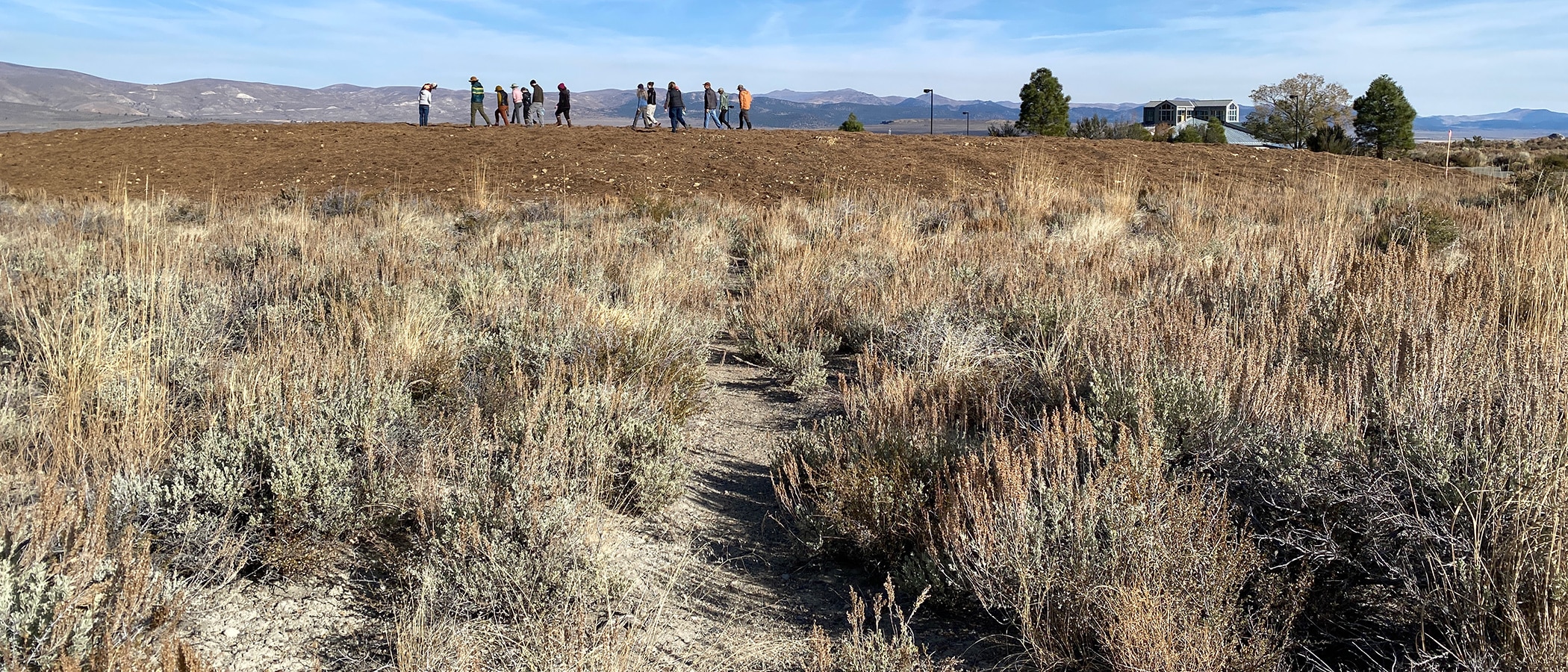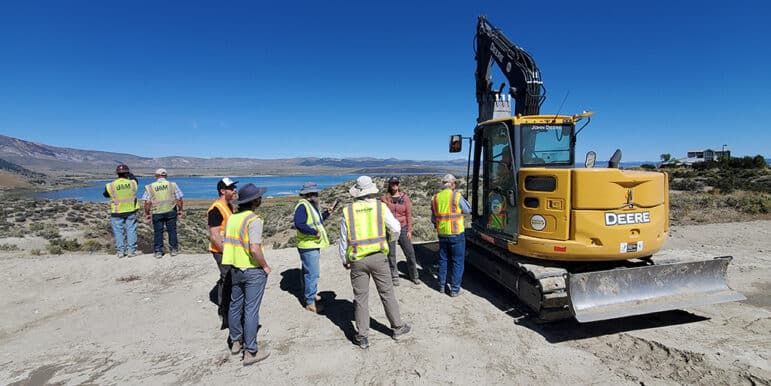
CalRecycle accepts settlement agreement and remedies project mistakes
Last fall the California Department of Resources Recycling & Recovery (CalRecycle) completed earth work on the former Lee Vining Burn Dump site adjacent to the Mono Basin National Forest Scenic Area Visitor Center. The work demonstrates the success of the two-year effort to convince CalRecycle to fix major damage caused by their contractors, which resulted from the absence of environmental documentation and permitting. The earth work is the critical, initial step toward the restoration of the site. Thanks to a focused coalition led by the Mono Lake Committee, expensive and time-consuming litigation was avoided, project missteps were reversed, and remediation and restoration achieved for the Scenic Area.
Inadequate public notice and scoping
The old dump site was largely invisible to the public and had long ago revegetated. However, annual inspections and testing indicated that soil and debris near the surface were out of compliance and requiring clean-up. A joint press release from CalRecycle and the Inyo National Forest announced the remediation project just days before it began in September 2021, but the public was not notified under the California Environmental Quality Act (CEQA). Because the project was located within the Mono Basin National Forest Scenic Area and adjacent to a State Scenic Highway, CEQA was not properly assessed. The public was given no opportunity to comment before earth moving equipment began leveling and clearing approximately three acres of ground. Only after the Committee inquired did CalRecycle post the CEQA notice—two weeks after construction began.

Scenic Area damage
What initially sparked alarm was the removal of a feature of the Visitor Center landscape. Excavators demolished a prominent, naturally vegetated, eight-foot-tall berm adjacent to the Visitor Center parking lot to use as capping fill for the project. The berm was constructed when the Visitor Center was built in the early 1990s and was an important landscape design feature that helped shield the Visitor Center from highway noise, traffic, wind, and drifting snow. The berm blocked views of the highway from Visitor Center guests and blocked the parking lot from passing motorists—it protected the view and focused the visitor experience toward Mono Lake. According to retired Regional Forest Service Architect Robert Sandusky, who was engaged with the Inyo on the planning and design of the Visitor Center and was contacted by the Committee after the berm demolition began, “The topography at issue was an essential part of the original design for the landscaping surrounding the area of the Visitor Center building and parking lot.”
Mounting issues
There were other issues with the project too. The contractor for CalRecycle generated unnecessary runoff and erosion. The Tribal monitor onsite for the Mono Lake Kootzaduka’a Tribe, Angela Eddy, raised several concerns, including an incident when the contractor’s water truck was left running unattended, flushing sediments off site toward Mono Lake. The contractor also built the engineered drainages incorrectly, spreading concrete on top of the grouted channel instead of between the rocks, at odds with the specifications agreed to by the Inyo.
More probing by the Committee revealed that CalRecycle had also failed to file a stormwater pollution prevention plan with the Lahontan Regional Water Quality Control Board (Lahontan). That plan is a routine, yet critical regulatory step in ensuring that stormwater runoff is planned for and controlled. Lahontan had no knowledge of CalRecycle’s remediation project and was not provided an opportunity to view or comment on the project design and erosion control plans.
Another necessary permit was also missed—CalRecycle did not publicly notice the project, nor submit a Section 1600 streambed alteration agreement with the California Department of Fish & Wildlife (DFW).
Cooperative solutions better than a lawsuit
Inadequate CEQA compliance, the removal of the berm, and other project shortcomings were unacceptable. The Committee threatened a CEQA lawsuit, which provided time and leverage to also propose a settlement agreement. Working collaboratively with Inyo National Forest, the Kootzaduka’a Tribe, Lahontan, and DFW, the Committee advanced an agreement that fully restored the berm, implemented a robust revegetation plan, and ensured the project was in proper compliance with necessary permitting.
Early in the process, when it became obvious that revegetation of the three-acre site would be critical for the restoration of scenic values, the Committee reached out to Michael Hogan, a Tahoe-based soil science expert who helped guide Caltrans’ revegetation of the Lee Vining Rockfall Project, a model for successful revegetation in the Eastern Sierra (see Summer 2018 Mono Lake Newsletter). The Committee also involved Regina Hirsch from Watershed Progressive, who has extensive restoration and revegetation experience and had worked with the Committee to improve the Mono Basin Outdoor Education Center’s landscape. Hirsch and her crew also installed one of California’s earliest permitted commercial greywater systems at the Committee’s Information Center & Bookstore in 2012.
Revegetation starts with soil
Drawing from decades of experience, as well as input from the Kootzaduka’a Tribe, Hogan drafted a revegetation and soil treatment plan that included specifications, prescriptions, and multi-year performance evaluations for successful revegetation. Hogan asserted that loosening, amending, mulching, and seeding the soil would in fact handle runoff ore efficiently than the old way of simply compacting the soil and spreading hydroseed and tackifier.
After sharing home-grown apples from his orchard one September afternoon, Hogan demonstrated with his own rainfall and runoff simulator that water running over a compacted surface accelerated erosion and prevented the soil from absorbing water. While it was a new way of doing work for CalRecycle, it was clear that site remediation and revegetation could be accomplished by loosening instead of compacting—allowing water to be retained by the soil and thereby promoting root growth.
The settlement agreement stipulated that an appropriately experienced revegetation inspector would direct the restoration process. CalRecycle hired Hirsch and Watershed Progressive to write and implement the final revegetation plan, in coordination with Hogan, as part of the revised work plan for the site. The revegetation plan was further refined and supported through permitting and compliance with DFW and Lahontan.
Bringing back the berm, healing the damage
With all the parties satisfied with the revegetation and final work plan, the Committee and CalRecycle signed a formal settlement agreement at the end of August 2023. By October the berm was reconstructed, the soil treated, and pine needle mulch and native seed applied throughout the site. While additional monitoring and revegetation work will continue, the heavy work with large equipment is complete. The dump site is stabilized and capped, restoration is on course, and permanent damage to the Scenic Area is averted. The Committee approaches problems, be they Scenic Area damage or water diversions, by standing strong on principles and looking for solutions to create a path forward, and it is rewarding to have these efforts deliver long-term benefits for visitors, habitat, the Scenic Area, and Mono Lake.
This post was also published as an article in the Winter & Spring 2024 Mono Lake Newsletter. Top photo by Elin Ljung: Part of the original landscape design for the Mono Basin National Forest Scenic Area Visitor Center, the eight-foot-tall berm has been reconstructed, mulched, and reseeded with native plants.
